Now let’s see how AFRICA is doing with IPv6!
AFRINIC IPv6 pool
IANA IPv6 pool shows these two allocations to AFRINIC:
- 2001:4200::/23 - Allocated on 2004-06-01
- 2c00:0000::/12 - Allocated on 2006-10-03
The IANA AFRINIC IPv6 page has a good analysis of AFRINIC’s IPv6 activities, including forecast on its IPv6 pool. Read more
AFRINIC fees schedule indicates that members with IPv4 do not pay extra fees for IPv6. For IPv6 Only members, 50% discount on the Allocation fee and 100% discount on the first year's membership fees will be applicable. For the three subsequent years, 75%, 50%, and 25% discount on the membership fee will apply respectively.Read more
The new fees schedule proposed in 2018 has not yet been finalized and implemented. It proposes some changes on the fees model and structure. Members shall pay according to these formulas:Read more
- Annual fee = MAX(IPv4 fee, IPv6 fee, ASN fee)
- Allocation or assignment fee = MAX(IPv4 fee, IPv6 fee, ASN fee) + 0.5 * (Second highest of(IPv4 fee, IPv6 fee, ASN fee))
AFRINIC IPv6 statistics provide the distribution over the years and by country and show a total of 10,553 /32 issued since the beginning. The map below shows the number of IPv6 allocations by member country (regardless of size).
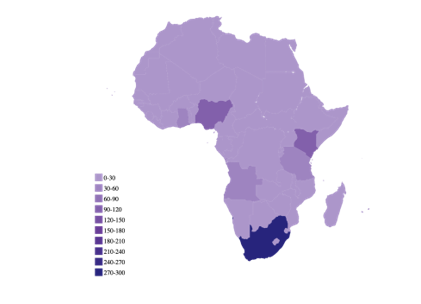
Source : https://stats.afrinic.net/ipv6/
These statistics indicate that in AFRINIC service region, only “Central African Republic”, “Eritrea” and “Mayotte” have no IPv6 issued.
Below is the percentage of members with IPv6 in each RIR. At AFRINIC, more than 50% of the members have both v4 and v6. Compared to LACNIC, with whom we share some similarities in terms of IP space usage and allocation, one can say, AFRINIC is not doing well.
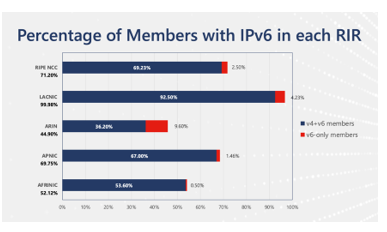
What’s about the networks, infrastructures, services, and users?
To assess how IPv6-friendly are the services in AFRICA, we found interests in the following major initiatives which measure,quantify and qualify IPv6 adoption through many aspects:
- Cisco 6Lab: Cisco 6lab presents consolidated metrics of IPv6 adoption, globally and at country level. Data are based on original data from RIR, routeviews, Alexa, Google, ITU, APNIC. Read more
- APNIC labs: Ad-based measurements with results on IPv6 uptake, users per AS, IPv6 relative performance, fragmentation and extension header drop rates... Read more
- Google: Google collects statistics about IPv6 adoption in the Internet on an ongoing basis from google search. Read more
- IPv6 Matrix: The IPv6Matrix is a tool to gather and visualize data on IPv6 deployment and accessibility around the world. Data is regularly gathered by crawler and is available to view on the website as soon as it has been processed. Read more
- Cloudflare Radar: Cloudflare Radar is a hub that showcases global Internet traffic, attack, and technology trends and insights.Cloudflare Radar is powered by data from Cloudflare's global network, as well as aggregated and anonymized data from Cloudflare's 1.1.1.1 public DNS Resolver. In some cases Cloudflare Radar uses data from PeeringDB (interconnection meta-information) and APNIC (visible ASNs customer population measurements). Read more
Cisco 6lab with its data sources and methodology offers a good view to the IPv6 deployment we are trying to measure.
It presents data on:- IPv6 Prefixes: Activity on prefix, according to APNIC Labs and Eric Vyncke's data
- Transit AS: IPv6 readiness of the Internet core - IPv6 transit AS and IPv6 enabled transit AS
- Content: IPv6 reachability of top-500 websites visited by users of some countries
- Users: Percentage of users based on APNIC labs and Google data
- Overall: Based on a compound of all IPv6 metrics - overall deployment ratio and relative deployment index.
We will use Cisco 6Lab as the main source of data for this analysis and corroborate data with other sources when needed.
IPv6 Overall Deployment
The picture below shows AFRICA at a global scale but unfortunately, it is lagging.
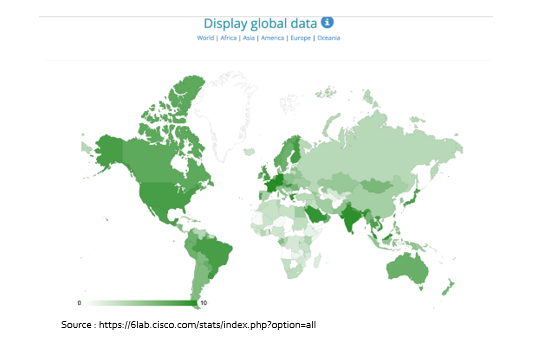
Source : https://6lab.cisco.com/stats/index.php?option=all
Only two countries pass 5 out 10 on the relative index. Gabon and Rwanda.

These countries are followed in the order by Reunion, Egypt, and Togo. Most countries have low IPv6 deployment
Let’s now look at the breakdown and see where things are more challenging.
1- IPv6 users.
The user side is shown here in terms of IPv6 preferred users per countries, by percentage of IPv6 preferred users on a map, but also by the estimated number of IPv6 preferred users on a table with color indication of the percentage. The distribution per region from APNIC labs is attached.
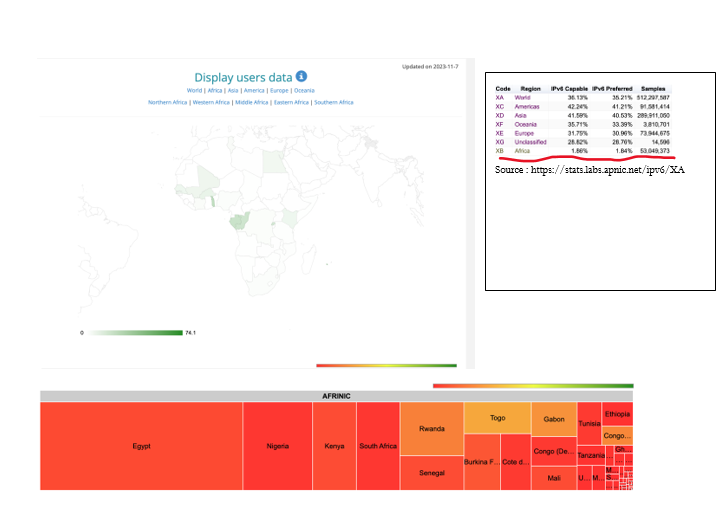
Source : https://6lab.cisco.com/stats/index.php?option=users
It seems that this is where the problem lies the most. Africa shows 1.86% of IPv6 capable compared to the world average of 36.13%
Reunion, Togo, Gabon, Congo, and Rwanda are leading in terms of percentage. Egypt, Nigeria, Kenya, and South Africa are leading in terms of IPv6 users.
To better understand the status of the leaders in percentage, one can look at the “Visible ASNs: Customer Populations (Est.)” from APNIC labs. Link where cctld is one of RE|TG|GA|CG|RW.
Except Reunion (which is a French department in the region), AS36924 seems to be the determining factor.
Canal-box has a good proportion of IPv6 users by default in countries where they operate and based on their market share, it impacts the level of IPv6 preferred users. Seen at Cloudflare radar, AS36924 has a traffic’s distribution of 63% of IPv6 and 37% of IPv4.
For the countries with big IPv6 preferred users, it is also notable that only one AS is being the determining factor. AS36992 in Egypt.
2- IPv6 Prefixes
The map below shows ratio of allocated v6 prefixes that are routable to all allocated v6 prefixes. Algeria and Niger are leading with 75% of allocated prefixes seen in the routing table. These countries have respectively six (06) and four (04) /32 allocated.
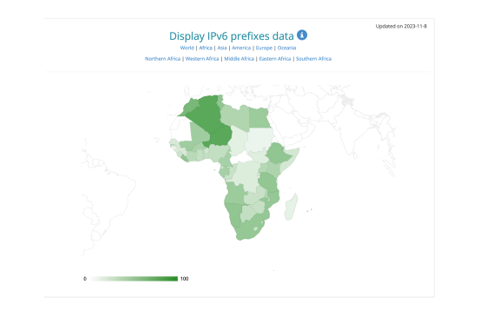
Source : https:// 6lab.cisco.com/stats/index.php?option=prefixes
When it comes to ratio of “allocated v6 prefixes to allocated v4 prefixes” and ratio of” allocated IPv6 prefixes from which traffic has been seen to all allocated v6 prefixes”, things are different. For example, Algeria and Niger show 37,5% and 0% for the latter.
South Africa which is first in terms of IPv6 allocation in the region shows the following:

3- Transit AS
From the IPv6 prefixes, the next metric to measure is the level of IPv6 readiness of the core of the internet. Cisco 6lab analyzes the BGP routing table and measure the IPv6 enablement of transit ASs.
The map below shows the representation of African countries in terms of “weighted ratio of AS that are transit V6 to AS that are transit V4 (IPv6 transit AS).
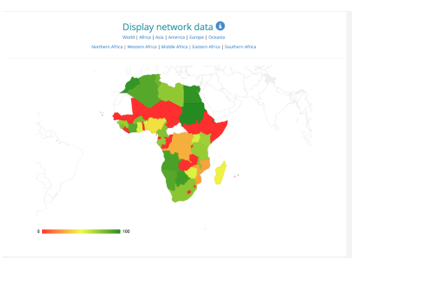
Source : https://6lab.cisco.com/stats/index.php?option=network
Sudan, Egypt, and Morocco are leaders here. The overall does not look good, and when it compares to the rest of the world, Africa’s position is not appealing.
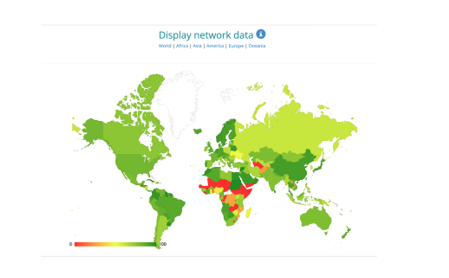
Source : https://6lab.cisco.com/stats/index.php?option=network
When it comes to IPv6 enabled transit AS (AS that is transit on IPv4 network and has an IPv6 prefix but is not necessarily transit on IPv6 network), countries have a much better representation. This shows an existing potential for evolution or changes.
4- Content
The last metric is the content over IPv6 per country. IPv6 enabled website is used to measure this. The map below shows a weighted ratio of IPv6 enabled websites per country.
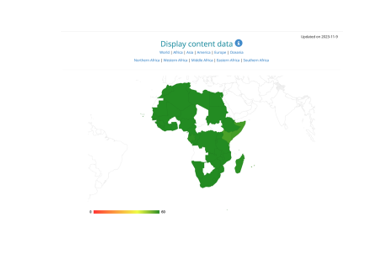
Source : https://6lab.cisco.com/stats/index.php?option=content
The overall looks good, even though, this metric does not check the hosting, as some sites may not be hosted in-countries. It does indicate that top websites visited by users from countries are reachable over IPv6.
In conclusion,
Africa is not leading in IPv6 deployment as predicted by the optimistic. The problem lies inside the network (core and edge). The edge may be more difficult, but the excuses will not hold forever. Other regions are moving, and the gap is already widening. Further work items could be to run surveys to assess the motives of those offering v6 access and the hesitance of others. African Internet users want access to the same, meaningful and resilient Internet.